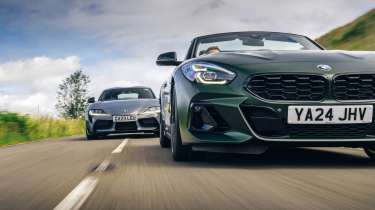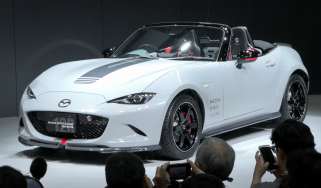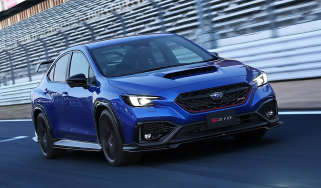BMW Z4 M40i Handschalter v Toyota Supra – manual sixes go head-to-head
Can the addition of a manual gearbox and a raft of chassis mods transform BMW’s Z4? And does it have the measure of its manual Toyota Supra cousin?
Sitting a manual gearbox to a long-established model makes little sense in the context of car makers’ efforts to improve efficiency and lower their corporate CO2 levels. Today’s automatic ’boxes deliver better economy and performance, essentially because they have a couple more ratios than a manual and can offer a more efficient use of power and torque. Shift speeds are faster than ever too, and if it’s a DCT (dual-clutch transmission) the connection feel between the throttle and the driven wheels is as good as that of a manual gearbox.
Logically, then, a manual is regressive, a backward step, and yet, at the eleventh hour, after five years in production, BMW has decided to put a six-speed manual and three pedals in the six-cylinder Z4. Rather than saying ‘why?’, we say ‘what took you so long?’ because the Z4 isn’t meant to be a practical, sensible choice, and a manual might give it some much-needed driver engagement and appeal.
> BMW M5 saloon 2024 review – more power, more weight, same old M5 desirability?
Until now, you could only have the Z4 with an eight-speed ZF auto and, to be honest, it seemed to fit the aspirations of the model and its customers down to the ground. Why the change of heart? Probably not market pressure because the Z4 has consistently been the biggest seller in this roadster segment. It finds a big market in Germany, the UK and the US, and while we think of America as auto-dominated, it’s a market that also believes that your sports car doesn’t earn the title unless it’s available with a stick shift – and then, when you’ve gone to the effort of making one, doesn’t buy it. Witness the E60 M5 having a manual ’box in the US only (the rest of us didn’t miss much; it wasn’t a slick shift), where it accounted for less than seven per cent of sales.
More reviews
The lack of a manual hasn’t held the Z4 back in any market, so perhaps the reason for fitting one now is more prosaic. BMW and Toyota collaborated to create the Z4 and Supra, and Toyota has already done the leg work, employing ZF to fashion a six-speeder to mate up with the 3-litre straight-six. The manual launched in 2022 and it works well, lending the Supra another layer of appeal and engagement, something the Z4 could certainly benefit from.
BMW calls the new model the Z4 M40i Handschalter, or hand shift. It says that the gearbox ‘uses M-specific components for the gear-set and shafts, along with a custom-made shift lever and linkage’, which is pretty close to Toyota’s description of the work that went into creating the Supra gearbox. And a look at the technical specs reveals that the gear ratios and final drive of the Z4 and Supra are identical. In both, the manual saves 15kg over the auto, although despite that – and a lower final drive – they are each slower than their auto counterparts, if only by a tenth or two. But that’s not the point.
There’s more to the Handschalter Pack than just three pedals and a gearlever, though. The model also gets a revised chassis with new, mixed-size wheels – 19s at the front, 20s at the rear – stiffer front anti-roll-bar mounts and revised tuning of the steering, rear dampers and adaptive M differential. The distinct colour you see here is ‘Frozen Deep Green’, a unique colour for the model that is paired with ‘Cognac’ leather interior trim. Coincidentally, when Toyota launched the manual Supra it did so with a special edition with matt paint and Cognac leather…
It’s a curious, late mirroring from a joint enterprise that has so far seen so little. The two marques have avoided direct sales conflict by dint of the BMW being available only as a convertible and the Toyota only as a coupe, but underneath they share the same basic platform, suspension and drivetrains and are built at the same Magna Steyr factory in Graz, Austria.
Get the two cars side-by-side and it’s hard to believe they share so much because they look so different. The Z4 looks bigger, wider especially, an impression reinforced by those big, shiny-rimmed wheels, which stand out compared with the Supra’s smaller-looking, gunmetal grey, forged wheels. The Z4 is a rather lumpy-looking car though, somewhat unresolved, while the Supra has taken a bit of heritage and blended it with echoes of Dodge Viper at the rear to create something compact and sporty. It too is in an optional metallic colour here – which went unnoticed as it looked flat grey until the sun came out and its curves and sculpting were accentuated.
Having already spent a couple of days in the Supra, the Z4 is as different to be in as to look at, feeling wider across the cabin. A quick game of ‘spot the shared parts’ throws up similar seats, a number of the same switch panels but in different locations, and the still-excellent BMW rotary controller for the HMI. As in the Supra, the first and most vital use for this, which will have you pulled over at the side of the road within a few miles, is to seek out how to disable the intensely annoying and overly sensitive lane keep assist of both cars.
Push the start button and the classy beat of the BMW-sourced, 335bhp, single-turbo in-line six sounds louder than in the Toyota, and not just because there’s only a fabric roof between you and the tailpipes. The Supra seems to have become more muted, perhaps due to the need for gas particulate filters in the exhaust, but the Z4 shows that you can get more voice. The delivery in the Z4 seems slightly different too, taking a few more revs to get going but then building to a bit more of a crescendo, which makes it a touch more exciting.
Much focus, though, is on the gearshift, and it should come as little surprise to discover that the shift actions of the two cars are probably their most similar characteristics. The lever in the Z4 is topped by the time-served, almost teardrop-shaped BMW knob, and this gives a very slightly different shift feel. It’s fairly light but well defined, as BMW shifts have tended to be, but it’s usefully more robust, not as elastic or knuckly as earlier BMW manuals. In both cars a slick shift is combined with a reasonably weighty, easily modulated clutch, though some credit for ease of use needs to be given to the outstanding engine mapping of the straight-six in both cars. There’s rev-matching in both, too; you can switch it off, but it’s so subtle that you barely notice it, assuming instead that you’re aceing every heel-and-toe downshift.
So far, so good for the Handschalter, then, and there’s more good news on the dynamics front, too. The bespoke chassis mods have created a Z4 that feels quite different and works off a surprisingly robust platform for a convertible. Pop the bonnet and you’ll see aluminium braces that run from the strut tops to the slam panel (European Supras don’t have them) but there must be plenty of hidden strengthening too to compensate for the open cockpit because it quickly becomes obvious that the Z4 has remarkable structural integrity. There’s the odd faint twitter, but hood-down there’s a total absence of shimmy and shake (and very little wind buffeting). Building on this solidity, the handling of the Z4 feels well balanced and composed, even on some of the gnarliest roads West Yorkshire has to offer.
It has an abundance of grip too, being shod with Michelin Pilot Super Sports, 265/35s at the front and massive 295/30s at the rear, so you can carry speed with confidence. The disappointment is the steering. The feel through the fat-rimmed wheel is a bit soft and lacks the detail that would allow you to place it with real precision, so while you can admire the handling and exploit the strong grip and traction out of tight corners, you don’t feel as involved and in charge as you should be.
The Toyota is even more different than you might expect. You get the same high scuttle that makes judging the extremities a challenge, and then on top of that, literally, you have the coupe roof, which makes the cockpit darker and more confined in feel. The straight-six is more muted and different in character, too. In the BMW its delivery is pretty conventional, taking a little while to get into its turbocharged stride, but the Toyota pulls astonishingly well virtually from tickover and just gets stronger and stronger, as if it has a chunk less kerb weight to haul. That’s not the case – there’s only around 50kg between the two, the Supra being lighter, but it feels thrillingly faster.
In the Supra there’s a different, more tactile connection with the car too. The steering wheel is quite big and leather-clad like the BMW’s but much thinner-rimmed, and while the feedback and linearity of the steering itself aren’t brilliant, the wheel rim gives a firmer and finer point of contact. We also marginally prefer the round-topped Supra gear shifter, which is like a leather-trimmed Chupa Chups lolly and sits nicely in your hand. Easing it around the gate, short-shifting and letting the willing straight-six dig deep is wonderfully satisfying and ramps up the appeal of the Supra. The eight-speed auto would be shuffling the gears to match the torque to the throttle demand, but this is such a flexible and tractable engine and so linear in its delivery that it feels as if maximum torque is available almost everywhere. You can revel in high-gear/low-rev combinations that would make an auto gearbox software engineer’s teeth itch.
Both companies talk up the 50:50 weight distribution of their cars and the Z4 does feel like the two ends share the load equally. In the Supra, not so much. You feel as though you’re sitting almost on the rear axle, and while the ride is more supple initially, on these fast and occasionally lumpen roads, it can feel a bit free. A press of the Sport button tightens things up nicely and adds weight to the steering, but the sense that the rear axle is under pressure and a little short of answers persists. On stretches where the Z4 is confident, the Supra runs short of poise. It’s the same driving out of corners: the Z4 hooks up and goes with little fuss while the Supra (also shod with decent-sized Michelin Pilot Super Sports), seems to struggle, rolling and running out of traction and composure but also sharp, almost like it’s hitting the bump-stops.
Dynamically, the BMW has the better composure then, even though it’s a convertible, yet despite them both being powerful, rear-drive sports cars with direct throttle connection, you don’t feel encouraged to go looking for oversteer in either. In the Z4 it’s because there’s little feedback through the steering to tell you how hard you’re pushing. It’s a lack of connection familiar from previous Z4s, so although it’s the best Z4 in Handschalter trim, with a slick, positive and easy shift, it’s still not quite there, still more of a cruiser than a scratcher.
The Supra is a car that feels more comfortable at seven or eight tenths too, or simply loping along in a high gear, riding the torque curve. It’s the more appealing car of the pair, better looking and with more exciting performance. And while the handling is imperfect, we know from longer exposure that you learn how to get the best from it.
The irony is that there’s a potentially great sports car here if you were able to combine the best bits of both cars – the unruffled chassis of the Z4 and the tactility of the Supra, the engine note of the Z4 and the brilliant flexibility, temperament and pace of the Supra. And the manual shift? Either will do the job beautifully.
Specs
| BMW Z4 M40i | Toyota GR Supra 3.0 | |
| Engine | In-line 6-cyl, 2998cc, turbocharged | In-line 6-cyl, 2998cc, turbocharged |
| Power | 335bhp @ 5000-6500rpm | 335bhp @ 5000-6500rpm |
| Torque | 369lb ft @ 1600-4500rpm | 369lb ft @ 1600-4500rpm |
| Weight | 1550kg | 1502kg |
| Power-to-weight | 220bhp/ton | 227bhp/ton |
| Tyres | Michelin Pilot Super Sport | Michelin Pilot Super Sport |
| 0-62mph | 4.6sec | 4.6sec |
| Top speed | 155mph (limited) | 155mph (limited) |
| Basic price | £55,350 | £57,130 |
This story first featured in evo issue 325.




